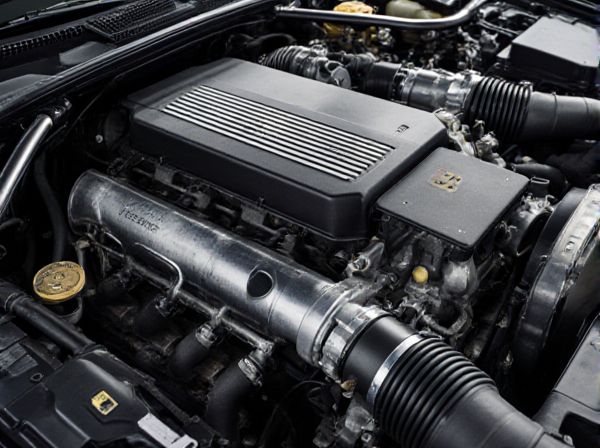
Photo illustration: Direct Injection vs Port Injection
Direct injection delivers fuel directly into the combustion chamber, enhancing power and fuel efficiency by improving atomization and combustion control. Port injection sprays fuel into the intake manifold, promoting better mixing with air and reducing intake valve deposits. Your choice depends on the desired balance between performance, emissions, and engine complexity.
Table of Comparison
| Feature | Direct Injection (DI) | Port Injection (PI) |
|---|---|---|
| Fuel Delivery | Injects fuel directly into combustion chamber | Injects fuel into intake port before the intake valve |
| Fuel Efficiency | Higher efficiency due to precise fuel control | Moderate efficiency with less precise fuel delivery |
| Power Output | Improved power and torque from better combustion | Standard power output with consistent delivery |
| Emissions | Lower NOx and CO2 emissions with lean burn capability | Higher emissions due to less efficient combustion |
| Carbon Buildup | Possible carbon deposits on intake valves | Less carbon buildup; injectors clean intake valves |
| Cost | Higher manufacturing and maintenance costs | Lower cost and simpler design |
| Common Applications | Modern gasoline engines, turbocharged systems | Older engines, budget-friendly models |
Understanding Direct Injection and Port Injection
Direct Injection delivers fuel directly into the combustion chamber, enhancing engine efficiency and power by enabling precise fuel atomization and improved air-fuel mixture control. Port Injection sprays fuel into the intake manifold before the intake valve, promoting better fuel vaporization and reducing intake valve deposits. Understanding these injection methods helps optimize engine performance, emissions, and fuel economy based on specific driving conditions.
Key Differences Between Direct and Port Injection
Direct injection delivers fuel directly into the combustion chamber, allowing precise control over fuel delivery and improved fuel efficiency. Port injection sprays fuel into the intake manifold, mixing with air before entering the combustion chamber, which reduces carbon buildup on intake valves. Direct injection typically achieves better power output and lower emissions, while port injection offers smoother engine operation and lower production costs.
Fuel Efficiency: Which System Performs Better?
Direct Injection systems deliver fuel directly into the combustion chamber, allowing for more precise control of fuel delivery and better atomization, which improves fuel efficiency by optimizing combustion. In contrast, Port Injection sprays fuel into the intake manifold, mixing with air before entering the combustion chamber, generally resulting in less precise fuel control and slightly lower efficiency. Studies show that Direct Injection engines can achieve fuel economy improvements of 10-15% compared to Port Injection systems due to reduced fuel wastage and improved air-fuel mixture management.
Impact on Engine Performance
Direct injection delivers fuel directly into the combustion chamber, resulting in improved fuel atomization and more precise control over combustion, which enhances power output and fuel efficiency. Port injection sprays fuel into the intake manifold, promoting better air-fuel mixing and reducing carbon buildup on intake valves but may offer less precise fuel metering compared to direct injection. The combination of direct and port injection technologies, known as dual injection, leverages the benefits of both systems to optimize engine performance, emissions, and fuel economy.
Emissions and Environmental Considerations
Direct Injection engines typically produce higher levels of particulate matter and NOx emissions compared to Port Injection systems, due to precise fuel spray timing and in-cylinder combustion. Port Injection systems tend to generate fewer particulates by promoting better air-fuel mixing before entering the combustion chamber, resulting in lower particulate emissions and cleaner combustion. Emission control technologies such as particulate filters and selective catalytic reduction are often necessary to mitigate the increased pollutants from Direct Injection engines and meet stringent environmental regulations.
Maintenance and Longevity Comparison
Direct injection engines often require more frequent maintenance due to the buildup of carbon deposits on intake valves, which can affect performance and longevity. Port injection systems generally experience less carbon fouling, leading to reduced maintenance needs and potentially longer engine life. Proper use of fuel additives and regular servicing can mitigate issues in both systems, but port injection tends to offer greater ease of upkeep over time.
Cost Analysis: Direct vs Port Injection
Direct injection systems typically cost 20-30% more than port injection due to their complex high-pressure fuel pumps and precision components. Maintenance and repairs for direct injection engines also incur higher expenses, with fuel injector replacements costing up to twice as much as those in port injection systems. Port injection remains more budget-friendly for initial installation and long-term servicing, making it a cost-effective choice for many consumers.
Common Applications in Modern Vehicles
Direct injection is commonly used in modern turbocharged gasoline engines for improved fuel efficiency and power output, while port injection remains prevalent in naturally aspirated engines for its cost-effectiveness and simplicity. Many hybrid vehicles utilize a combination of direct and port injection, known as dual injection, to optimize combustion across varying engine loads. Diesel engines predominantly employ direct injection systems due to their high compression ratios and precise fuel delivery requirements.
Pros and Cons of Direct Injection
Direct Injection (DI) offers improved fuel efficiency and increased power output by injecting fuel directly into the combustion chamber, allowing for precise control over the fuel-air mixture. However, DI engines often face challenges such as carbon buildup on intake valves, which can lead to reduced engine performance and require more frequent maintenance. Despite these drawbacks, DI technology generally provides better combustion efficiency and lower emissions compared to traditional Port Injection systems.
Pros and Cons of Port Injection
Port injection offers advantages such as improved fuel atomization and better mixing with air before entering the combustion chamber, leading to smoother engine operation and reduced intake valve deposits. It allows for more flexible fuel delivery and generally lower injector costs compared to direct injection systems. However, port injection's efficiency is limited at high engine loads and speeds, and it typically provides less precise fuel control than direct injection, potentially resulting in higher emissions and lower fuel economy.
 caratoz.com
caratoz.com